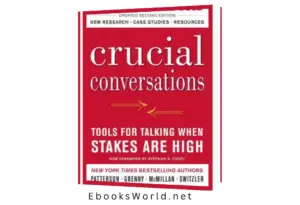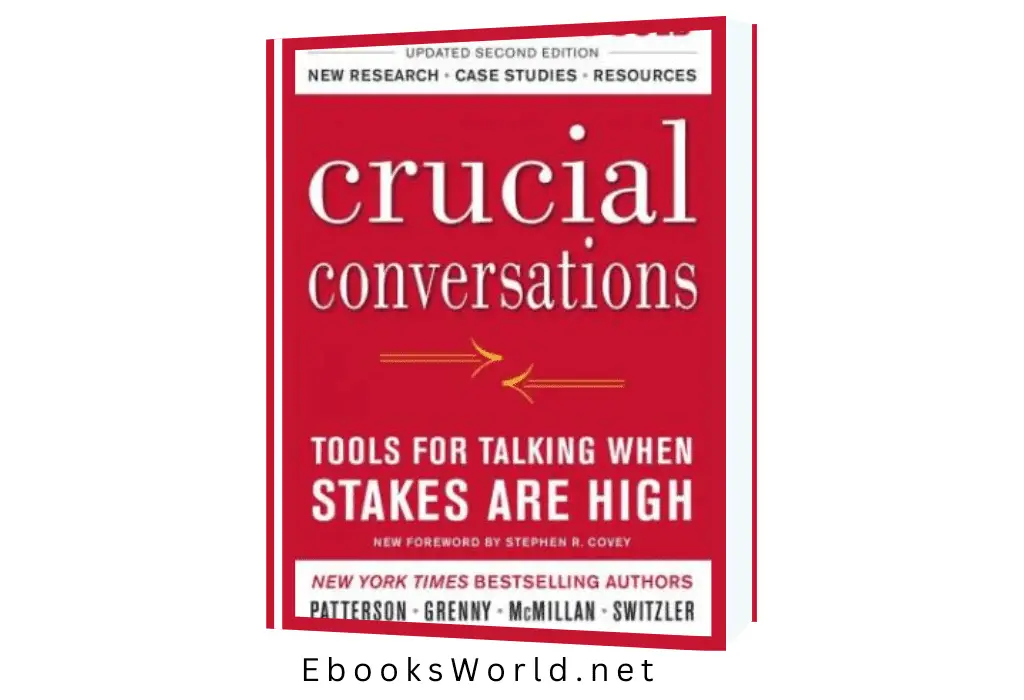Crucial Conversations

Ratings
“Crucial Conversations: Tools for Talking When Stakes Are High” by Kerry Patterson, Joseph Grenny, Ron McMillan, and Al Switzler is a book that provides valuable insights and tools for effectively navigating high-stakes conversations. The authors emphasize the importance of mastering crucial conversations to achieve personal and professional success.
Here’s a summary of the key concepts in the book:
1. What Are Crucial Conversations? Crucial conversations are discussions where the stakes are high, opinions vary, and emotions run strong. These conversations can occur in both personal and professional settings, and how they are handled can significantly impact relationships, decisions, and outcomes.
2. Dialogue vs. Debate : The authors highlight the difference between dialogue and debate. While debate often involves a win-lose mentality, dialogue encourages an open exchange of ideas. Mastering crucial conversations requires the ability to engage in dialogue, fostering mutual understanding and shared meaning.
3. Mastering Your Stories: People often tell themselves stories to make sense of situations, and these stories influence their emotions and behavior. The book suggests identifying and challenging the stories we tell ourselves during crucial conversations to ensure that they are accurate and constructive.
4. Stay in Dialogue When It Matters Most: Maintaining open communication during crucial conversations is essential. The authors introduce the acronym “AMPP” (Ask, Mirror, Paraphrase, Prime) as a tool to help stay in dialogue. Asking questions, mirroring, paraphrasing, and priming are techniques that facilitate effective communication and understanding.
5. Make It Safe: Creating a safe environment is crucial for successful crucial conversations. People are more likely to be open and honest when they feel safe. The authors discuss the importance of mutual respect and shared purpose in establishing safety.
6. Master Your Emotions: Emotions play a significant role in crucial conversations. The book advises recognizing and managing emotions to prevent them from derailing the conversation. Techniques such as contrasting (explaining what you don’t intend) and creating a shared pool of meaning can help manage emotions effectively.
7. Explore Others’ Paths: Understanding others’ perspectives is key to successful communication. The authors introduce the concept of “Clever Stories” – stories that help us understand why others may see things differently. By exploring these stories, individuals can gain insights into the underlying motivations and concerns of others.
8. Move to Action: The ultimate goal of crucial conversations is to reach a positive outcome. Moving to action involves creating a plan and holding oneself and others accountable. The book provides a framework called the “Six-Step Process” to guide individuals in turning dialogue into results.
9. Learn and Improve: Crucial conversations provide opportunities for learning and improvement. The authors emphasize the importance of reflection and continuous improvement in mastering the art of dialogue. Learning from both successful and unsuccessful conversations contributes to personal and professional growth.
10. Applying Crucial Conversations: The book concludes with practical advice on applying the principles of crucial conversations in various contexts, including the workplace, personal relationships, and everyday life. The authors provide real-life examples and case studies to illustrate the application of the book’s concepts.
In this summary, “Crucial Conversations” offers a comprehensive guide to navigating difficult conversations effectively. By mastering the art of dialogue, managing emotions, and creating a safe environment, individuals can improve their communication skills and achieve positive outcomes in high-stakes situations. The book’s practical tools and techniques make it a valuable resource for anyone seeking to enhance their communication and conflict resolution skills.







